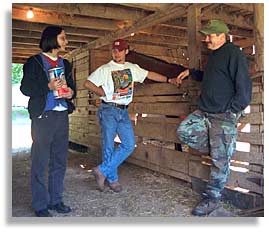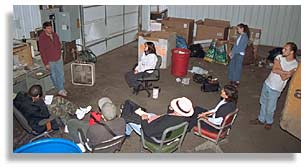|
An interview with performance artist
Stephanie Juno Part 2 - Uncharted waters Interview by Nic Paget-Clarke Whitesburg, Kentucky
The following interview (part 2) with Stephanie Juno is part of a series of interviews with some of the members of a group of 25 artists from around the U.S. and Canada who went to Kentucky and Virginia to participate in the initial stages of a multi-year, multi-site community art project sponsored by the American Festival Project. The American Festival Project is based in Whitesburg, Kentucky with Appalshop, a regional community arts center. Also see: Fred Campbell, Rodrigo Duarte Clark, Harrell Fletcher, Shannon Hummel, Suzanne Lacy, John Malpede, Robbie McCauley, Nobuko Miyamoto. Both liminal and interstitial at the same time In Motion Magazine: As someone who works in a city do you see any concrete differences between the way art is in a rural setting and in cities? Does the fact that this is a rural area make any difference? Stephanie Juno: I haven't been to the gallery we're going to tomorrow, but I've been in Appalshop. Appalshop is a lot like the Richmond Art Center but they went in a different direction, with media. In Motion Magazine: A different direction? Stephanie Juno: The Richmond Art Center is more visual art oriented because we have exhibitions as well as jewelry, weaving, ceramics, painting studios. Appalshop went towards radio and video. They went more towards communications and we went more towards visual art. But they are both community art centers that are deeply rooted in the community. They employ people from the community. They serve the people in the community. They promote the artists and community members, community organizations. In that sense, I find them very similar. I don't have the sense that people identify themselves as artists here in the same way as people in an urban setting can. I don't find this shockingly different from what I thought it would be or from other places I've been. It's incredibly unique but it's uniqueness doesn't have to do with its difference. There's something else about it. It's both liminal and interstitial at the same time. In Motion Magazine: You are going to have to explain that one. Stephanie Juno: It's liminal in the sense that it's off the map. It literally falls outside of zoning. There's no zoning here. There's areas where there ar no hookups to water or sewer. It's like it supposedly doesn't exist. And yet it's interstitial in that it so clearly exists and it's so interconnected to so many things, to so many people and to so many places. It has such an intensely deep history. It's simultaneously those two things in a really wonderful way. That's what makes it unique to me. Uncharted waters
Stephanie Juno: I think it always has in many ways. The WPA is a concrete institional example. But on a much more personal level, the individual has gifted and influenced the community through art. There have always been individuals who created community art whether they meant to or not. Even if it was out of an intense desire to prove some individuality, it has since become this incredible gift to the community. Such as Watts' Towers in Los Angeles as John Malpede was saying earlier today. Or Howard Finster's Paradise Garden in Georgia. Any time an individual makes artwork it becomes part of the public interaction, the public domain, and it affects the community. It can affect the community positively or negatively. It can be about the community or not. People have gone all over the gamut of the spectrum. I think Appalshop has always had a direct and overt connection between the work that they do and the work that needs to be done in their community. They have not separated those two things as an institution.. Some artists do and they don't. This method, and there is a method, was clear to me before I came here. Then, when I was here it seemed suddenly the method was incredibly abstract. It seemed like the initial conception only carried me so far and then I seemed to be in uncharted waters. And that's fine. My initial conception was, and still is, what we are doing is we're flying in the face of other community work that in my opinion has been limited and even short-sighted. The idea that an artist can go into a community for a week and do a residency of any range, scope, or depth is hard for me to understand. In Motion Magazine: How does this method deal with that? Stephanie Juno: Instead of one artist or two artists it brings in twenty-five and tries to match them to communities, to mobilize a much larger one-to-one match of people. The fact that the visitors are living with community members is a whole other thing. You can't go back to a motel room and separate from what's happening. Some of the most important things that happen happen at midnight but if you away from what is happening and you are in your motel room, alone in bed and asleep, then you are not there. I think that is strategic. Also, the fact that it's twenty-five people instead of one is strategic. If you are going to do community work then you bring in a community to the community. I don't know if it works but as far as I know it hasn't been done before and the other approach doesn't always work so we might as well try this. Otherwise I shouldn't have ever come It is interesting because it begs so many questions about what is a community of artists. Why do the artists clump together when they have the opportunity? How do they buoy themselves up to make forays into the community when they might not have ever done it alone? Because they were nervous or afraid or tired? All the mundane reasons why we just can't quite reach out as far as we could? In Motion Magazine: So how do you think it's going? Stephanie Juno: I think it's going great. I must be involved in a creative process because I'm having the same feeling I have when I'm creating a performance work, except the disconcerting thing is as far as I know I'm not creating a performance. I have an intense feeling of being unworthy. When you are in the creative process you feel like you are at the point of something, and you can see this enormous vista and it makes you feel at that point very small. Also, I can see how some artists are dealing with it. They are saying, "Do you have any ideas?" I see that question, and I could be projecting my own interpretation, but as the idea to create something comes you feel better about what you are doing here. You have something to hang on to. You say, "I have this idea." What is interesting is everyone has dug in their heels and said, "No, we don't." As a vanguard we are going to hang in there as long as possible and not get any ideas. It seems premature to have any ideas at this point. Completely premature. If I were creating a performance from this information I'd be looking for things that wouldn't rise to the surface as part of the normal process. I'm looking for other things. I'm looking for things that get flagged for different reasons, like "Oh, this is a completely unusual perspective or way of looking at this". Those are things I'm paying attention to. In Motion Magazine: How do those things relate to problems in the community that need to be resolved? Stephanie Juno: They come back and they say that they are. Those are the things I'm looking for. I'm looking for the promising avenues for problem solving. Perspectives that could interact with the community problems in a direct way. We are all looking for the right answer in a really complex problem. The right answer may not be the answer. It isn't an answer maybe. I put my faith in the process. You have to. Otherwise I shouldn't have ever come.
Published in In Motion Magazine October 4, 2000. |
||||||||||||||||||||||||||||||
If you have any thoughts on this or would like to contribute to an ongoing discussion in the  What is New? || Affirmative Action || Art Changes || Autonomy: Chiapas - California || Community Images || Education Rights || E-mail, Opinions and Discussion || En español || Essays from Ireland || Global Eyes || Healthcare || Human Rights/Civil Rights || Piri Thomas || Photo of the Week || QA: Interviews || Region || Rural America || Search || Donate || To be notified of new articles || Survey || In Motion Magazine's Store || In Motion Magazine Staff || In Unity Book of Photos || Links Around The World NPC Productions Copyright © 1995-2020 NPC Productions as a compilation. All Rights Reserved. |
||||||||||||||||||||||||||||||



